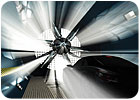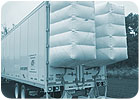
Using a wind tunnel helped mimic real-life conditions. Source: ATS
Aerodynamic Trailer Systems Ltd. (ATS, Auburn, OH) has developed a new product that fits on commercial trailer doors to provide a more aerodynamic shape to the rear of the trailer. The objective is to create a green technology product that reduces emissions by improving fuel efficiency of over-the-road trucks.
The product, an inflatable boattail, is an aerodynamic device that reduces drag caused by air flowing in a random, turbulent manner around the rear of a commercial trailer. The design effectively changes the flat surface of the rear doors to a curvilinear shape. It is constructed from a heavy-duty flexible polymer material that automatically inflates and deflates by means of a blower and valving system at pre-set highway speeds. In the deflated position, the rear doors can be fully opened for loading freight.
“The inflated boattail is a uniquely curved shape that is very difficult to pre-determine on engineering drawings or measure, which makes it difficult to model,” says Jim Domo, ATS chief executive officer. “We wanted to measure the aerodynamic profile of the device. Since a truck trailer is too big to fit in a wind tunnel facility, we needed to create a scaled model that would describe the exact physical shape. In parallel, we needed a digital version of the boattail in order to perform a software-based computational fluid dynamics (CFD) analysis.”

The device attaches to the rear of the truck and reduces drag. Source: ATS
Data Management Delivers
ATS contacted 3D Scan IT Inc. (Royal Oak, MI), to discuss alternatives to traditional data gathering techniques. 3D Scan IT technicians recommended a noncontact, high-density scanner as a data gathering approach, and brought an Imetric-IScan White Light scanner to the company’s facility.“We first used photogrammetry to set up navigation points on the surface of the boattail, and then we performed a complete scan using the Imetric white light scanning system,” says Bob Squier, 3D Scan IT Inc. president. “The scanning process took about three hours.”
The data was acquired using the PolyWorks software suite. A total of 62 scans were taken and registered to the photogrammetry coordinate system. The aligned scans were then processed to create a polygonal mesh that removed all the overlapping scan data while removing the fabric texture and reducing the file size.
Precision Model
ATS also wanted to test the boattail performance in a wind tunnel. “The goal was to create a file that we could use in a rapid prototyping process to quickly create a ⅛ scale model of the boattail device that would be used for performance testing in a wind tunnel,” said Patrick Ryan, president of ATS.To perform the simulation, the polygonal model was sent to the Auto Research Center in Indianapolis. This wind tunnel testing facility, designed primarily for testing race cars, is an open jet, rolling road design that accurately replicates highway conditions.
To create a scaled model of the boattail, they used a Stratasys FDM 8000 rapid prototyping machine and the watertight polygonal model.
“We planned to use that wind tunnel test data to make any last-minute design changes to the device before we went into production, so it was critical to our program that the model be as accurate as possible,” Ryan says.
First, a curve network was created by using the curve extraction and editing functions of IMEdit. Automatic NURBS surface fitting procedures create the surfaces as the curves are completed. The PolyWorks IMInspect module was used to align the model to the global coordinate system of the trailer doors since the boattail had to exactly fit the door area without obstructing the hinges.
The optimized NURBS model was sent to specialists from NASA to perform CFD analysis. This analysis provided a quick overview of the aerodynamic performance of the inflatable boattail under various conditions.
The NURBS model also was exported to ATS’s SolidWorks software suite to be used for future modifications and production purposes.
Reducing Fuel Consumption
According to Domo and Ryan, the ⅛ scale model of the boattail created by the laser scanning and point cloud data management process was a dimensionally precise model of the full-size device, virtually an exact replica.
“We were confident that when we conducted wind tunnel testing we would get meaningful results that would apply directly to the full-size device,” Ryan says.
Test results indicated that the boattail could reduce fuel consumption by up to 5%.
“That translates into fewer emissions and reduced fuel costs through the improvements in aerodynamic drag on the trailer,” says Domo.
A traditional approach to product design and development would simply not have achieved the results for which the company was looking.
3D Scan IT
(248) 545-5399
www.3dscanit.com
Benefits
- Fuel consumption was reduced by up to 5%.
- Truck emissions are reduced.
- Drag is reduced by causing air to flow in a random pattern.